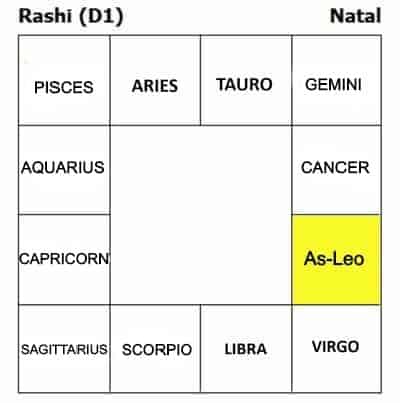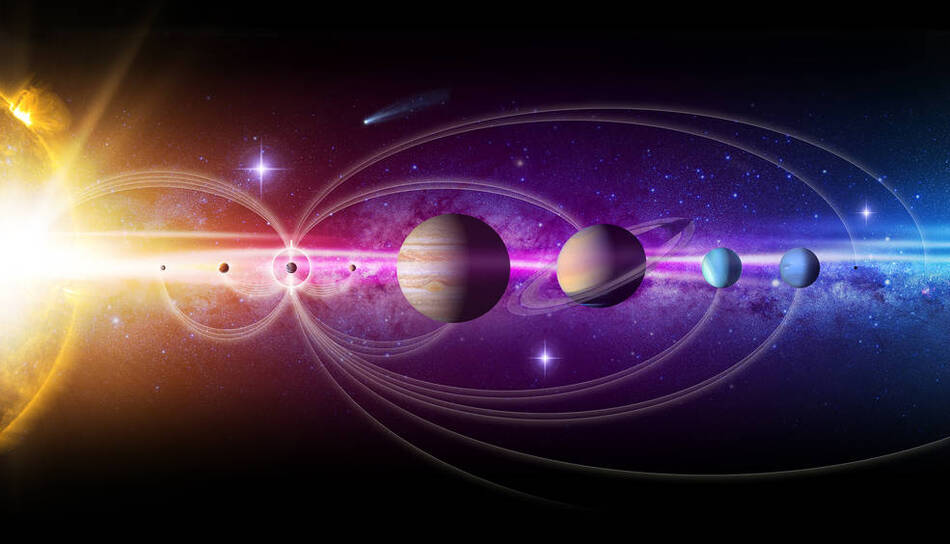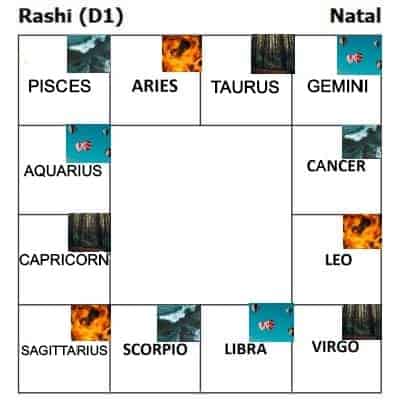
You’re interested in Vedic Astrology , but there is so much information floating around in cyberspace (and not all of it reliable) that you don’t know how to begin. I have assembled an overview of five fundamental concepts in Vedic Astrology to get you started. I also address some common questions and points of confusion that never seem to be answered by others. Let’s begin with the signs of the zodiac.
, but there is so much information floating around in cyberspace (and not all of it reliable) that you don’t know how to begin. I have assembled an overview of five fundamental concepts in Vedic Astrology to get you started. I also address some common questions and points of confusion that never seem to be answered by others. Let’s begin with the signs of the zodiac.
Zodiac Signs – Rashis
There are 12 signs, also known as Rashis, in the zodiac.
- Aries
- Taurus
- Gemini
- Cancer
- Leo
- Virgo
- Libra
- Scorpio
- Sagittarius
- Capricorn
- Aquarius
- Pisces
Why are there 12 and not some other number?
Let’s see what NASA in the USA has to say about this.
The Babylonians lived over 3,000 years ago. They divided the zodiac into 12 equal parts–like cutting a pizza into 12 equal slices. They picked 12 constellations in the zodiac, one for each of the 12 “slices.” So, as Earth orbits the Sun, the Sun would appear to pass through each of the 12 parts of the zodiac [1].
National Aeronautics and Space Administration (NASA)
This is true for Western Astrology, but only partially true for Vedic Astrology. The ancient Hindus had been practicing a form of Vedic Astrology for at least 2,000 years before the Babylonians devised their system. Given their similarities (a system based upon 12 signs), it is likely that the Babylonians borrowed elements of the Vedic system and incorporated it into their own.
So, why 12? Our ancestors spent a lot of time studying the stars. They noticed that different star constellations appeared in the sky just before dawn depending on the time of the year. We now know these appearances occur along the ecliptic (orbital) plane of the Earth. They mapped these appearances and saw that there was a predictable pattern of 12 constellations that had minimal overlap with each other. For a more detailed explanation, I recommend my article on the relationship between Astrology and Astronomy .
.
The Babylonians originally had 13 signs in their zodiac, but eliminated Ophiuchus (the 13th) because there was too much overlap with other constellations. Other cultures have identified 24 signs.
The Nakshatras
In Vedic Astrology, the 12 signs of the zodiac are defined by 27 Nakshatras. These also are referred to as constellations, such that the two often are used interchangeably. However, this can be confusing for those from Western cultures that are accustomed to thinking of constellations, such as Aries the ram or Taurus the bull, as defined clusters of stars that correspond to certain familiar shapes. Nakshatras, on the other hand, actually are fractions of these larger constellations. For example, Taurus the bull is composed of approximately 2.25 Nakshatras.
Each of the 27 Nakshatras covers 13° 20’ of the plane of Earth’s orbit around the Sun known as the ecliptic. Each Nakshatra is also divided into quarters or padas of 3° 20’. These divisions aid in the precision of calculations.
There always is a Nakshatra projecting on a particular part of the Earth. It is then followed by a different one, and then another, in a cyclical movement. Think of it like a PowerPoint presentation consisting of 27 slides, each showing on the screen for the same amount of time.
A zodiac sign therefore is in effect for the duration of about 2.25 Nakshatras (27/12) on the ecliptic plane. However, the Earth also is spinning on its axis. As it does so, each zodiac sign rises in the sky for an average duration of 2 hours. Most of these we cannot see because they occur during daylight hours. An overcast sky or excessive light at the ground level also can affect visibility during nighttime hours.
The ascendant sign – Lagna

The sign that is rising in the sky at a given point in time and is affecting a particular part of the Earth is called the ascendant or Lagna. The 12 zodiac signs rise one after the other in a cyclical movement, completing the series in approximately one day. Thus, the same periodicity is measurable both over a year and throughout each day.
Each person on the planet has an ascendant sign. It is determined by knowing the day that you were born, the time that you were born, and the place where you were born. An ascendant sign is different from your Sun sign, which is used in Western Astrology. You only need to know the day that you were born and consult a Western zodiac chart to determine your Sun sign.
Almost everyone knows this. For example, a person born on March 30 would say that his zodiac sign is Aries. But this information only refers to the sign that the Sun was in on that day, taking into account the Tropical Zodiac used in Western Astrology. However, the ascendant sign in Vedic Astrology is based on three important data points: the day, the time, and the place of birth. This analysis will give a different result than the Sun sign calculation used in Western Astrology.
Given its unique position, each zodiac sign has its own set of characteristics and inclinations. These in turn are influenced by your sign’s ruling planet and positions of other planets relative to it, the house in which your sign is located, and effects of elements and modalities with which your sign is associated.
The fact that none of us lives in a vacuum means that we are also shaped by external factors such as cultural mores, social conventions, familial values, and peer influences, as well as our own personal experiences. Taken together, our ascendant astrological sign along with external factors form the foundation on which our lives are built.
The Houses – Bhavas
Our Earthly lives unfold through a physical body in a world of matter as shown through the Bhavas [2].
Sam Geppi
Similar to Western Astrology, there are 12 houses (Bhavas) in Vedic Astrology. They are presented in two formats. The North Indian system uses a diamond-grid chart, whereas the South Indian system employs a rectangular-grid chart. One is not better than the other. They are merely different ways of organizing the exact same information. I focus here on the rectangular grid, since it is the one most commonly used and easiest to understand.

As you can see in the figure, each box contains one zodiac sign. This configuration never changes. The twelfth house, containing Pisces, always is located in the top left corner box. The next box to the right is the first house, containing Aries. From there, the other houses are represented in sequence in a clockwise manner. This configuration is known as the natural zodiac.

Representation of the ascendant sign
The ascendant sign for an individual is represented by a single diagonal line across a box on the grid or by the abbreviation AS. In the figure above, this is Leo.
Once the ascendant sign is identified, it becomes the first house on the grid with a corresponding shift of the other houses in a clockwise manner. However, the positions of the signs on the grid remain the same; only the house numbers change. For example, in the natural zodiac, Taurus is in the second house. However, in our sample grid above, Leo is the ascendant. Therefore, it is the first house and Taurus shifts to become the 10th house.
This can be confusing at first. Just remember. If a grid has a diagonal line running through one of the boxes or the abbreviation AS, then the ascendant has been identified and it is the first house. If there is no diagonal line or AS in any of the boxes, then this is the natural zodiac and Aries is the first house.
Are Bhavas really houses?
Equating Bhavas with houses is unfortunate, but we are stuck with it because of tradition. When we think of a house, it conjures an image of a shelter from external threats (weather, animals, robbers, etc.) However, Bhava is almost the opposite. It literally means emerging into existence or birth.
Vedic Astrologer and teacher Sam Geppi states that it is through what is shown through the Bhavas that our Karma is born materially. Thus, we understand that houses in Vedic Astrology do not represent shelters or refuges, but instead present unique contexts through which the light of our birth under a particular ascendant sign shines.
is born materially. Thus, we understand that houses in Vedic Astrology do not represent shelters or refuges, but instead present unique contexts through which the light of our birth under a particular ascendant sign shines.
The Planets – Navagrahas

Vedic Astrology focuses primarily on 9 celestial bodies.
- Sun
- Moon
- Mercury
- Venus
- Mars
- Saturn
- Jupiter
- Rahu
- Ketu
These are collectively referred to as planets, even though only five actually are planets.
What is the reason for calling all 9 planets?
There is no special significance behind representing the Sun and Moon as planets. It is a convenient shorthand. It simply is easier to assign all 9 as planets, rather than to constantly distinguish between those celestial bodies that are planets and those that are not. Moreover, for Vedic Astrology, the distinction has no meaning or usefulness in most cases.
Further complicating matters, Rahu and Ketu neither are planets nor are they even celestial bodies. They are shadow planets with no physical existence. Instead, they are mathematical points in the sky. Nevertheless, they can have significant influences on your life if they affect the ruling planet of your ascendant sign or when you pass through their Mahadasha. The Mahadasha refers to the grand period of a planet. For Rahu, this is 18 years; for Ketu, it is 7 years.
As the table below shows, each sign of the zodiac is ruled by a corresponding planet. The 5 actual planets rule two signs each, the Sun and the Moon each rule one, and Rahu and Ketu rule none. To rule, in Vedic Astrology, does not mean the same thing as ruling families in a monarchy. Instead, the role of planets is more like that of a guide or influencer. For more information, I recommend that you read my article about how the planets rule in Vedic Astrology.
in Vedic Astrology.
| Zodiac Sign | Ruling Planet |
|---|---|
| Aries | Mars |
| Taurus | Venus |
| Gemini | Mercury |
| Cancer | Moon |
| Leo | Sun |
| Virgo | Mercury |
| Libra | Venus |
| Scorpio | Mars |
| Sagittarius | Jupiter |
| Capricorn | Saturn |
| Acuarius | Saturn |
| Pisces | Jupiter |
The Elements – Tattvas

Ancient Vedic texts known as the Upanishads teach us that the universe and everything in it emanated from one fundamental vibration of “Om.” From “Om,” five elemental vibrations called tattvas radiate. These five tattvas, or aspects of reality, comprise all material bodies and are believed to form the basis of all our experience. They are Earth (Prithvi), Water (Jala), Fire (Agni), Air (Vāju), and Ether (Ākāsa). Each is associated with a planet – Mercury for Earth, Venus for Water, Mars for Fire, Saturn for Air, and Jupiter for Ether.

As you can see in the figure above, each tattva is associated with 3 specific zodiac signs (trees represent the earth and globes represent the air). Each of the tattvas also represents a state of matter. The Earth does not refer only to the ground, but to everything solid in nature. Water is everything that is liquid. Air is everything that is a gas. Fire transforms one state of matter into another. The solid state of water (ice) is transformed into water (liquid) and then into vapor, its gaseous state. Eliminating fire causes this progression to reverse.
Ether, also referred to as Space, is the mother of the other elements. It pervades all of the signs and represents Vishnu, the preserver and protector of the universe. Vishnu pervades everything, but is not visible to the human eye. The experience of Ākāsa tattva as luminous emptiness is the basis of higher spiritual experiences.
The Gunas
The five tattvas comprise three types of behaviors or qualities, called gunas. They are sattva (harmony, light, purity, knowledge), rajas (avarice, appetite, restlessness, passion), and tamas (rigidity, laziness, darkness, ignorance).
Philosopher Theos Bernard states that the gunas are present in everyone and everything. It is the proportion of them that is different at the individual level and at any given point in time. The interaction of these gunas establishes a person’s (or object’s) character and determines their progress in life [3].
Each tattva is associated with a particular emotion and one of the 5 senses. In Vedic Astrology, we do not view the tattvas as separate entities, but rather as all of them intertwined, with one assuming a dominant position. The associated emotion has no dichotomous value, as in positive or negative, good or bad. Instead the quality of the emotion at any given point in time is determined by the interplay of the three gunas.

Earth – Prithvi Tattva
Emotion: Greed
Sense: Smell
Earth is the most dense of the elements. As such, it also has a weighty psychological influence. Earth is our practical nature. But it’s emotion, greed, seems far from practical. How do we reconcile this?
We all think that we understand greed. The Oxford Dictionary defines it as intense and selfish desire for something, especially wealth, power, or food. However, this modern definition is only one of many possibilities, depending upon the alignment of the gunas. The ancient Vedas viewed greed from a much broader perspective.
In the modern definition of greed, rajas guna has a predominant influence. However, Swami Satyadharma suggests an alternative path in which sattva is prominent. From this perspective, we are greedy to spread truth, to possess a high moral caliber, and to become a great teacher [4].

Water – Jala Tattva
Emotion: Lust
Sense: Taste
Water specifically shows the flow of the senses from the physical body to the outer world and the emotional connections and impressions made through the senses. It is also our receptive emotional mind [5].
Sam Geppi
As before, the modern definition of lust carries a negative connotation that is dominated by rajas and tamas gunas. However, Swami Satyadharma identifies another path in which sattva guna predominates.
Rather than be lustful to exploit another person or the Earth for short-term personal gain, we can choose to channel the emotional energy of lust into a deep respect toward others and the environment. This changes our lustful attitude from one of exploitation to one of service [4].

Fire – Agni Tattva
Emotion: Anger
Sense: Sight
Fire is primarily responsible for the mind and mental impressions, while also being responsible for digestion of all sorts, whether digesting food or digesting information. Fire is also our active emotional mind, our passionate nature and the instinctual, conditioned/reactive mind. It is the element of Fire that digests sensory impressions (Water), turning them into thoughts we can use. Otherwise, our minds would be a jumble of sensory data [6].
Sam Geppi
When rajas and tamas gunas are prominent, we direct our anger towards others. In most cases, we try to avoid taking responsibility for our own actions (or lack of them) by diverting attention from ourselves to others. However, we can choose the sattva path of responsibility and get angry at our own negativity and self-destructive behaviors.

Aire – Vāju Tattva
Emotion: Attachment
Sense: Touch
Air is responsible for our intellect. It represents our higher intellectual capabilities, along with our conscience and morals. Through Vāju tattva we observe and interact socially with the world.
The associated emotion for air is attachment. Again, instead of being attached to earthly possessions, we can be attached to the idea of a healthy, happy life, and the moral imperative of not wanting to see people suffer.

Ether (Sky) – Ākāsa Tattva
Emotion: Pride; negative ego
Sense: Hearing
Ether is primarily responsible for consciousness. The element of Ether corresponds to pure consciousness itself – our awareness. It is the layer of being beyond the four gross physical elements. Ether refers to the witnessing consciousness, that which is able to perceive the thought process and remain unidentified with it. It is our intuitive nature, connection to freedom and the closest to our true Self [7].
Sam Geppi
Instead of exerting untold amounts of energy attempting to protect your ego, which always will be a wasted effort, Swami Satyadharma recommends that we instead identify ourselves with the Creator. Have pride and gratitude that the Creator made you a human and provides you with a path to enlightenment. If you have the Ākāsa Tattva (Ether) predominant, then you will be the happiest, most carefree being in the world [4].
As the mother of the other elements, Ākāsa tattva has an influence on all of the zodiac signs, although in most instances it is indirect. The remaining four elements influence three signs each. The chart below shows how they are distributed.
Zodiac signs associated with the same element share some similarities but, at the same time, can be quite distinct. They are like siblings in the same family.
The Modalities
There are three modalities in Vedic Astrology: movable, fixed, dual. Each has four associated zodiac signs, as illustrated on the grid below.
Whereas tattvas form the basis of our experience and gunas elaborate its qualities, modalities portray distinct ways each group of signs expresses their element’s energy, responds to circumstances, and negotiates through life. Western Astrology also has modalities, called cardinal, fixed, and mutable. They basically correspond to those of Vedic Astrology.
As the table reveals below, each modality contains one sign from each of the four elements and each element contains one sign from each modality, indicating that their energy is evenly distributed.

Movable modalities
Movable signs are linked to motion. Aries, Cancer, Libra, and Capricorn natives tend to be people that take action. They either quickly engage in a project and take it to success or fail completely. But success or failure is not the important thing for them. It is the challenge of initiating the project. They are visionary and are known for creating something from nothing. Movable signs forge the paths that others follow and begin the endeavors that others finish.
Movable signs can be thought of as matter existing in the highest state of energy. In chemistry, this is a gaseous state.
Fixed modalities
The fixed signs, Taurus, Leo, Scorpio and Aquarius, have a talent for identifying exactly what needs to be done and then doing it. Although each of the fixed signs is connected to a different element, they are similar in that they are highly focused, hard-working, and great at developing a plan and sticking to it.
Fixed signs are firm, fixed in position. They occupy the lowest (solid) energy state. Fixed signs generally take longer to start but never seem to stop. While movable signs like to make things work, fixed signs like to own them. They want to be the boss and let the movable signs do the work for them.
Dual Modalities
The dual modality is exactly what you might expect. It is a middle ground between the excessive activity of movable signs and the stubborn resistance of the fixed signs. It operates at a medium state of energy (liquid).
Movable signs always want to be in motion and fixed signs want everything else to move around them while they sit still. Dual signs are changeable and adaptable. When things don’t go according to plan, dual signs are able to adjust and complete a project anyway.
They thrive on challenge and are willing to compromise to achieve a goal. Whereas a fixed sign might insist that they are right and you are wrong, a dual sign would request to sit down and talk things through in hopes that the two of you could make a mutually satisfying arrangement.
Final thoughts
I have provided an overview of five fundamental concepts of Vedic Astrology. They are by no means a complete analysis of each, nor are they the only fundamental concepts. Rather, what I have presented here represents a starting point for further study. I wish you the best on your journey in the study of Vedic Astrology.
References
- NASA (2020). https://spaceplace.nasa.gov/
- Geppi, Sam (2005). The Ascendant: 108 Planets of Vedic Astrology. Lithia Springs, GA: New Leaf Distributing Co Inc, pp 50.
- Bernard, T (2007). Hindu Philosophy. New York: Philosophical Library.
- Swami Satyadharma Saraswati (2018). Yoga Tattva Upanishad: Essence Of Yoga, 2nd Ed. Scotts Valley, CA: CreateSpace Independent Publishing Platform.
- Geppi, Sam (2005). The Ascendant: 108 Planets of Vedic Astrology. Lithia Springs, GA: New Leaf Distributing Co Inc, pp 18.
- Ibid, pp 19.
- Ibid, pp 20.
Recent Content
The following is the story of the origin of Rahu, known in Western Astrology as the North Node of the Moon. Keep reading. There are several lessons to be learned in this...
A common form of forecasting in the modern world is that used by Meteorology. This science uses measurements, such as temperature, atmospheric pressure, humidity, and the behavior of the winds...
